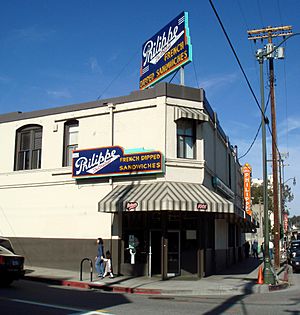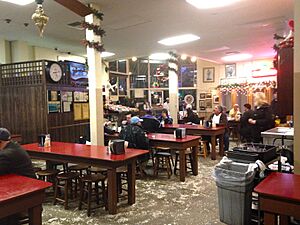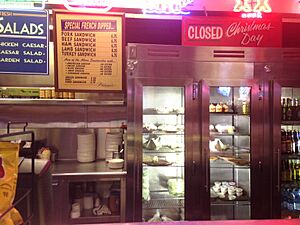Philippe's facts for kids
Quick facts for kids Philippe's |
|
|---|---|

Philippe's main entrance
|
|
| Restaurant information | |
| Established | 1908 |
| Current owner(s) | Martin and Binder families |
| Food type | French dip sandwiches |
| Dress code | Casual |
| Street address | 1001 N. Alameda Street |
| City | Los Angeles |
| State | California |
| Postal/ZIP code | 90012 |
| Country | United States |
| Coordinates | 34°03′35″N 118°14′13″W / 34.059588°N 118.236896°W |
| Reservations | No |
Philippe's, also known as "Philippe the Original", is a famous restaurant in downtown Los Angeles, California. It is one of the oldest restaurants in Los Angeles, having been open since 1908. Philippe's is also well-known for saying they invented the delicious French dip sandwich.
The restaurant has been at its current spot, 1001 North Alameda Street, since 1951. This location is near Chinatown, Olvera Street, and Union Station.
Contents
The Story of Philippe's Restaurant
Philippe Mathieu came to Los Angeles from France in 1903. He opened his first Philippe restaurant in 1908. At first, he served different kinds of roasted meats and other foods. His restaurants were in an area of Los Angeles called Frenchtown.
In 1918, Philippe moved his restaurant to Aliso Street. This is where he first started serving his special French dipped sandwiches. To avoid paying more rent, Mathieu bought his own building in 1925.
A few years later, in 1927, Philippe Mathieu sold the restaurant to brothers David and Harry Martin. The Martin family, along with their relatives the Binders, have owned and run Philippe's ever since. John and Richard Binder took over in 1985.
From 1927 to 1941, Philippe's was open all day and night. In 1951, the restaurant moved to its current location. This move happened because the Hollywood Freeway was being built. Philippe's is proud to be the longest continuously open restaurant in Los Angeles. This means it has never closed for a long time, unlike some other old restaurants.
Who Invented the French Dip Sandwich?
The story of how the French dip sandwich was invented is a bit of a mystery. Another restaurant, Cole's Pacific Electric Buffet, also says they invented it in 1908.
Here are three stories about how Philippe's French dip sandwich might have started:
- In 1951, Philippe Mathieu told a newspaper that a customer asked him to dip a French roll into the meat gravy. He did, and soon many others wanted the same. He quickly realized this was a popular idea.
- Another story says it happened because Philippe was trying to use up old bread. A firefighter complained his roll was dry. So, Philippe dipped it in the meat juices (called jus) to make it soft.
- The most common story is that Philippe accidentally dropped a roll into the pan drippings. A police officer who ordered the sandwich decided to eat it anyway. This "happy accident" story is often told when the real reason is not clear.
No matter how it started, the sandwich was first called a "dip sandwich." Because the restaurant was sometimes called "Frenchy's," the name eventually became "French dip sandwich."
What's on the Menu at Philippe's?
Philippe's feels like an old-fashioned deli. It has long tables where different groups of people share space. You might even see wood shavings on the floor, just like in old times! The walls are dark wood, and there are old newspapers from important U.S. events. Displays also show the history of railroads in Los Angeles. The restaurant has two floors with tables.
Philippe's is known for attracting all kinds of people. From everyday workers to important city leaders, everyone comes to eat here. At busy times, lines can be very long. Customers get their food cafeteria-style on paper plates. They carry their trays to the long tables. People from different backgrounds often sit together and share the homemade mustard.
In 2008, the health department asked Philippe's to remove the shared mustard jars. This was because of health rules. After a short time, the jars were replaced with plastic squeeze bottles, and the mustard was back on the tables.
Besides the famous French dip sandwiches, Philippe's serves other classic foods. These include fresh soups, beef stew, chili, and baked apples. Sides like potato salad, macaroni salad, and coleslaw are also popular. You can even find jars of purple pickled eggs on the counter. After 1985, healthier options like turkey sandwiches and salads were added.
Philippe's offers soft drinks, iced tea, lemonade, and coffee. They also have some wines and beer. Philippe's was famous for selling coffee for only 9 cents for a long time. On February 2, 2012, the price went up to 45 cents. Before that, the price had last changed in 1977.
For special anniversaries, like its 85th, 90th, 95th, and 100th, Philippe's has sold French dip sandwiches for only 10 cents and coffee for 5 cents for a few hours.
See also
- List of James Beard America's Classics
- Original Tommy's
- The Hat






